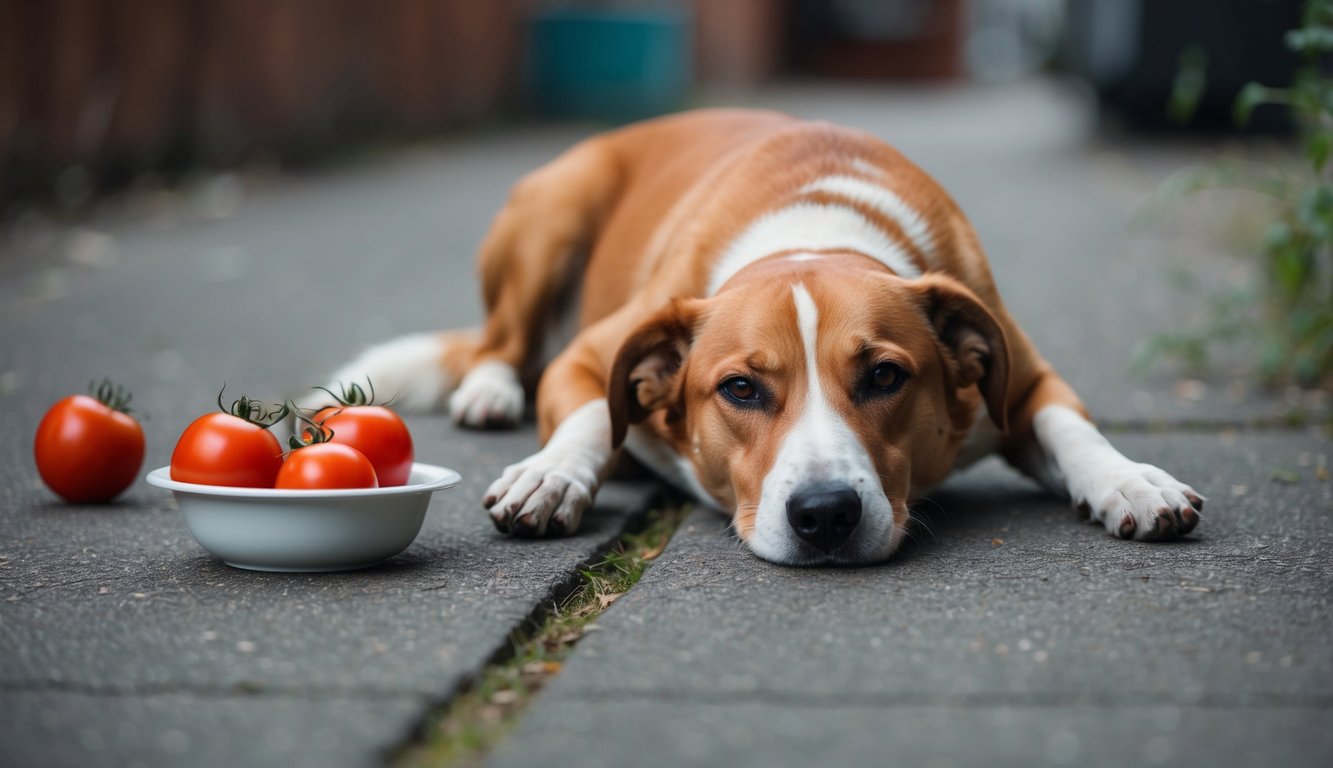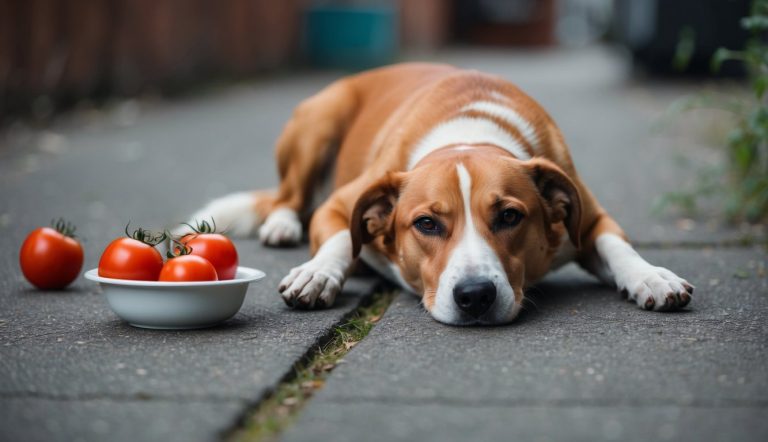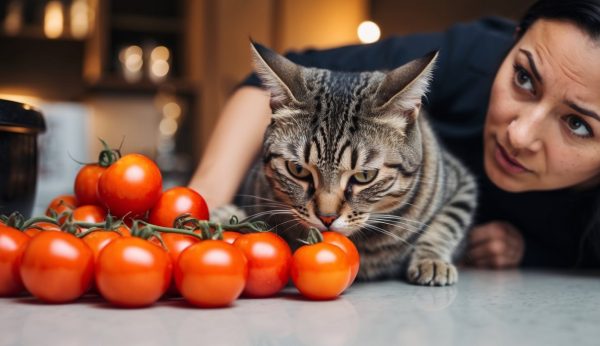Can Dogs Eat Tomatoes?
Ripe tomatoes can be fed to dogs in moderation, but not all parts of the plant are safe. Some parts contain toxins that can cause health problems if eaten.
Nutritional Value of Tomatoes for Dogs
- Tomatoes contain vitamins and minerals that can support your dog’s health. They are a good source of vitamin C, vitamin A, potassium, and fiber. These nutrients can help support your dog’s immune system, vision, and digestion.
- Tomatoes are also low in calories, making them a light treat. A few small slices can be a refreshing snack on hot days.
- Keep in mind that while tomatoes have some health benefits for dogs, they should only be given in small quantities. Too much can cause stomach upset.
Safe Tomato Parts for Dogs
- Only ripe, red tomatoes are safe for dogs to eat. You should remove all green parts, such as stems, leaves, and unripe fruit. These green parts contain higher levels of solanine and tomatine—two compounds that can be harmful to dogs if eaten in large amounts.
- It is best to offer cooked or fresh slices of ripe tomato, without the stem or leaves. Avoid feeding cherry tomatoes on the vine, canned tomatoes, tomato sauces, or anything with added salt, garlic, or onion.
- Wash the tomato before serving and cut it into bite-sized pieces to prevent choking.
Risks of Feeding Tomatoes to Dogs
- Some parts of the tomato plant contain solanine and tomatine, two substances found mostly in the leaves, stems, and unripe tomatoes. Ingesting these can cause vomiting, weakness, confusion, and a slow heart rate in dogs. Even ripe tomatoes have tiny amounts of tomatine, but not enough to cause poisoning if your dog only eats a small amount.
- Feeding too many tomatoes can also lead to an upset stomach and diarrhea. If your dog eats any green parts of the plant, watch for symptoms like drooling, loss of appetite, or tiredness.
Signs of Tomato Toxicity in Dogs

Ripe tomatoes are generally safe for dogs in small amounts, but parts of the plant and unripe tomatoes can be dangerous. Toxic compounds such as tomatine and solanine can cause health problems if your dog eats the wrong part of a tomato.
Symptoms to Watch For
If your dog eats unripe tomatoes, stems, or leaves, you may notice certain signs of toxicity. Common symptoms include:
- Vomiting
- Diarrhea
- Drooling
- Loss of appetite
- Weakness
Other, more serious symptoms can happen if more tomatine or solanine is consumed. Look for:
- Tremors or shaking
- Seizures
- Muscle weakness
- Loss of coordination
Even small amounts of green tomato parts can cause reactions in some dogs. The severity depends on the dog’s size, the amount eaten, and how sensitive your dog is. Prompt attention is important if you see any unusual behavior.
What to Do if Your Dog Eats a Harmful Tomato Part
- If you think your dog ate unripe tomatoes, stems, or leaves, remove any leftover plant material from your dog’s mouth. Make a note of how much was eaten and which part of the plant.
- Call your veterinarian right away. Give your vet the details such as your dog’s weight, age, and what symptoms you are seeing. If your dog starts vomiting or has seizures, seek emergency care immediately.
- Never try to treat tomato poisoning at home without expert advice. Your vet may suggest a check-up, monitoring, or treatments to prevent complications.
Safe Tomato Preparation for Dogs
Always serve tomatoes in a way that puts your dog’s health first. The type and amount you choose can help prevent stomach upset or risky reactions.
How to Serve Tomatoes Safely
- Only feed your dog ripe red tomatoes. Unripe tomatoes, along with the stems and leaves, contain solanine, a substance that can be toxic to dogs and cause symptoms like vomiting, drowsiness, or confusion. Always wash tomatoes well to remove dirt and any chemicals.
- Cut the tomato into small chunks to reduce choking risk, especially for small dogs. Remove all green parts, including stems and leaves, before serving. Offer tomatoes fresh. Avoid sauces, ketchup, and canned tomatoes, since these may have added salt, garlic, or onions which are dangerous to dogs.
Table: What Parts of the Tomato Are Safe?
| Part | Safe for Dogs? |
|---|---|
| Red, ripe flesh | Yes |
| Green parts | No |
| Leaves, stems | No |
Appropriate Portion Sizes
- Feed tomatoes in moderation. For most dogs, an occasional slice or a couple of small chunks is safe. Too much tomato can cause stomach upset or diarrhea, especially if your dog is not used to this food as explained here.
- For small dogs, start with one or two bites. For medium or large breeds, you can offer a slice or two but not the whole tomato. Introduce tomato slowly and check for any signs of allergies, such as itching or swelling.
- Always prioritize your dog’s regular balanced diet, making sure that snacks like tomato do not make up more than 10% of daily calories. If your dog has a sensitive stomach, skip tomatoes or consult your vet first.
Veterinarian Guidance on Tomato Consumption
Veterinarians agree that ripe tomatoes are safe for most dogs in small portions, but unripe tomatoes and green parts of the plant can be harmful. Paying attention to your dog’s reaction and their daily diet is important for their safety and health.
When to Contact Your Vet
Contact your vet if your dog shows any unusual symptoms after eating tomatoes. Watch for signs like vomiting, diarrhea, drooling, loss of appetite, or trouble walking. Tomato plants contain tomatine, a substance that can be toxic to dogs when eaten in large amounts or from unripe tomatoes and green leaves.
If you suspect your dog has chewed on a tomato plant or eaten green tomatoes, call your vet even if symptoms are mild. Young puppies, senior dogs, and dogs with health problems may be more sensitive to the effects. Quick action can help prevent serious issues.
Regular Pet Nutrition Advice
Dog nutrition should focus on a balanced diet tailored for your pet’s age, size, and activity level. Treats, including tomatoes, should be less than 10% of your dog’s daily food. Ripe tomato pieces, served plain and in moderation, can be a safe snack for most dogs, but they should never replace main meals.
Avoid feeding your dog tomato stems or leaves, which can contain higher levels of tomatine. Always wash tomatoes before serving to remove chemicals or pesticides. Dogs with certain health conditions or allergies may need special diets, so discuss any dietary changes with your veterinarian.




